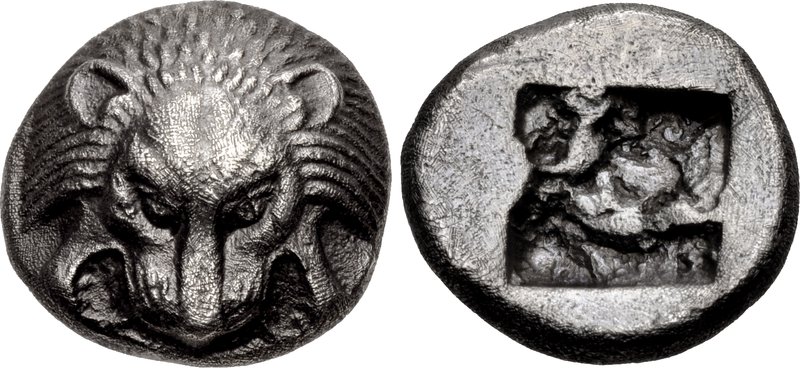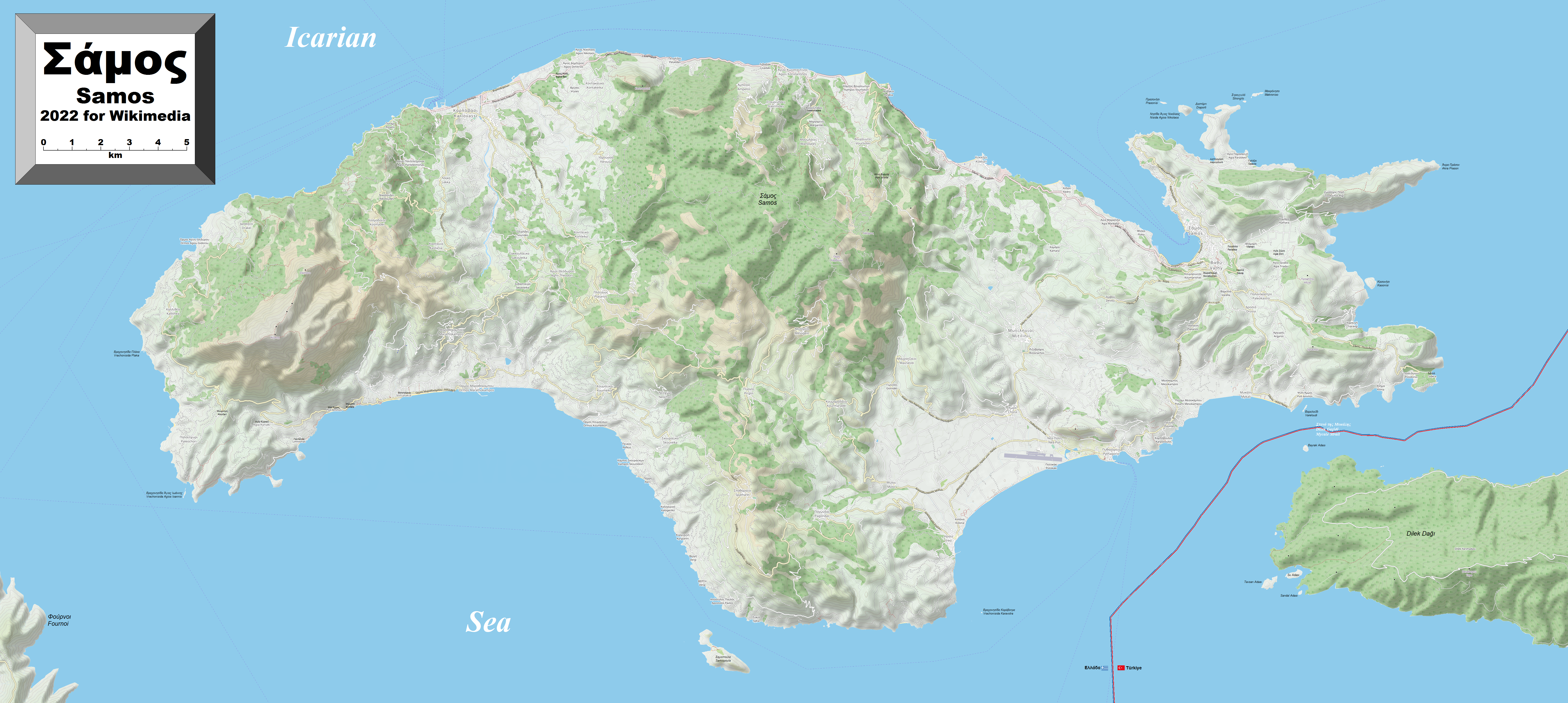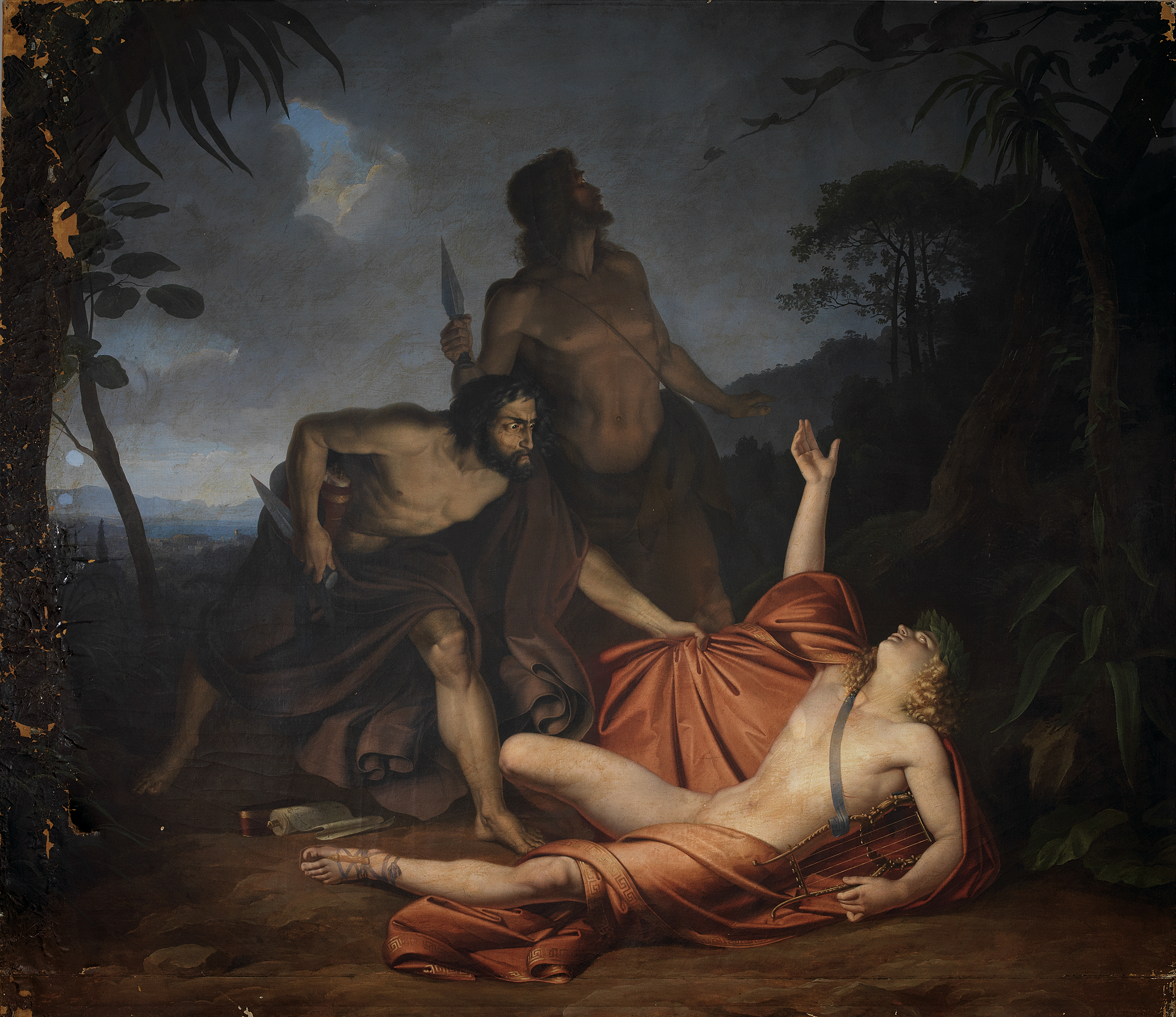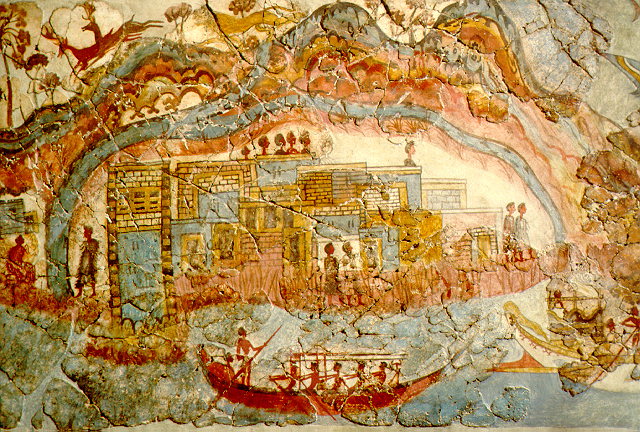|
Aeaces (father Of Polycrates)
Aeaces ( grc, Αἰάκης, fl. 550 BC) was the father of Polycrates, the powerful tyrant of Samos. He was a prominent aristocrat in his own right, and may even have been the ruler of the island for a period in the mid-sixth century. He is sometimes referred to as Aeaces I to distinguish him from his grandson Aeaces II, who ruled Samos in the late sixth and early fifth centuries BC. Life Herodotus mentions Aeaces' name but does not provide any information about his life. A very late source, the Suda, says that Polycrates' father was the ruler of Samos around 565 BC. His wealth and power is also suggested by his ability to attract the poets Ibycus and Anacreon to his circle – the former wrote poetry for the young Polycrates, while the latter was supposedly his tutor. A large seated statue of a goddess from the mid-sixth century BC, erected on the Astypalaea (the Samian Acropolis) bears an inscription identifying its dedicator as Aeaces. Stylistically, the statue appears to date ... [...More Info...] [...Related Items...] OR: [Wikipedia] [Google] [Baidu] |
Polycrates
Polycrates (; grc-gre, Πολυκράτης), son of Aeaces, was the tyrant of Samos from the 540s BC to 522 BC. He had a reputation as both a fierce warrior and an enlightened tyrant. Sources The main source for Polycrates' life and activities is the historian Herodotus, who devotes a large section of book 3 of his ''Histories'' to the rise and fall of Polycrates (3.39-60, 3.120-126). His account was written in the third quarter of the 5th century BC, nearly a century after Polycrates' death, was based mostly on oral traditions and incorporates many folk-tale elements. Furthermore, Herodotus creatively shaped his account of Polycrates in order to make general moral points and to comment on the imperialism of the Athenian empire in his own day. Some poetry from Polycrates' time comments on him in passing and there is a smattering of references to Polycrates in other literary sources ranging in date from the 4th century BC to the Roman Imperial period. These sources preserve ... [...More Info...] [...Related Items...] OR: [Wikipedia] [Google] [Baidu] |
Samos
Samos (, also ; el, Σάμος ) is a Greek island in the eastern Aegean Sea, south of Chios, north of Patmos and the Dodecanese, and off the coast of western Turkey, from which it is separated by the -wide Mycale Strait. It is also a separate regional unit of the North Aegean region. In ancient times, Samos was an especially rich and powerful city-state, particularly known for its vineyards and wine production. It is home to Pythagoreion and the Heraion of Samos, a UNESCO World Heritage Site that includes the Eupalinian aqueduct, a marvel of ancient engineering. Samos is the birthplace of the Greek philosopher and mathematician Pythagoras, after whom the Pythagorean theorem is named, the philosophers Melissus of Samos and Epicurus, and the astronomer Aristarchus of Samos, the first known individual to propose that the Earth revolves around the sun. Samian wine was well known in antiquity and is still produced on the island. The island was governed by the semi- ... [...More Info...] [...Related Items...] OR: [Wikipedia] [Google] [Baidu] |
Aeaces (son Of Syloson)
Aeaces, son of Syloson ( grc, Αἰάκης Συλοσῶνος) was the ruler of Samos in the late sixth and early fifth centuries BC. He belonged to an established dynasty of Samian rulers - his father Syloson had been installed as ruler of Samos by the Persian king Darius I around 520 BC and his uncle Polycrates had reigned before that. Aeaces was deprived of his tyranny by Aristagoras, when the Ionians The Ionians (; el, Ἴωνες, ''Íōnes'', singular , ''Íōn'') were one of the four major tribes that the Greeks considered themselves to be divided into during the ancient period; the other three being the Dorians, Aeolians, and Achae ... revolted against Persian rule in 500 BC. He then fled to the Persians, and persuaded the Samians to abandon the other Ionians in the sea-fight between the Persians and Ionians. After this battle, in which the latter were defeated, he was restored to the tyranny of Samos by the Persians in 494 BC. Notes References * {{SmithDG ... [...More Info...] [...Related Items...] OR: [Wikipedia] [Google] [Baidu] |
Archaeological Museum Of Pythagoreio 8
Archaeology or archeology is the scientific study of human activity through the recovery and analysis of material culture. The archaeological record consists of artifacts, architecture, biofacts or ecofacts, sites, and cultural landscapes. Archaeology can be considered both a social science and a branch of the humanities. It is usually considered an independent academic discipline, but may also be classified as part of anthropology (in North America – the four-field approach), history or geography. Archaeologists study human prehistory and history, from the development of the first stone tools at Lomekwi in East Africa 3.3 million years ago up until recent decades. Archaeology is distinct from palaeontology, which is the study of fossil remains. Archaeology is particularly important for learning about prehistoric societies, for which, by definition, there are no written records. Prehistory includes over 99% of the human past, from the Paleolithic until the advent of ... [...More Info...] [...Related Items...] OR: [Wikipedia] [Google] [Baidu] |
Herodotus
Herodotus ( ; grc, , }; BC) was an ancient Greek historian and geographer from the Greek city of Halicarnassus, part of the Persian Empire (now Bodrum, Turkey) and a later citizen of Thurii in modern Calabria ( Italy). He is known for having written the ''Histories'' – a detailed account of the Greco-Persian Wars. Herodotus was the first writer to perform systematic investigation of historical events. He is referred to as " The Father of History", a title conferred on him by the ancient Roman orator Cicero. The ''Histories'' primarily cover the lives of prominent kings and famous battles such as Marathon, Thermopylae, Artemisium, Salamis, Plataea, and Mycale. His work deviates from the main topics to provide a cultural, ethnographical, geographical, and historiographical background that forms an essential part of the narrative and provides readers with a wellspring of additional information. Herodotus has been criticized for his inclusion of "legends and fa ... [...More Info...] [...Related Items...] OR: [Wikipedia] [Google] [Baidu] |
Suda
The ''Suda'' or ''Souda'' (; grc-x-medieval, Σοῦδα, Soûda; la, Suidae Lexicon) is a large 10th-century Byzantine encyclopedia of the ancient Mediterranean world, formerly attributed to an author called Soudas (Σούδας) or Souidas (Σουίδας). It is an encyclopedic lexicon, written in Greek, with 30,000 entries, many drawing from ancient sources that have since been lost, and often derived from medieval Christian compilers. Title The derivation is probably from the Byzantine Greek word '' souda'', meaning "fortress" or "stronghold", with the alternate name, ''Suidas'', stemming from an error made by Eustathius, who mistook the title for the author's name. Paul Maas once ironized by suggesting that the title may be connected to the Latin verb ''suda'', the second-person singular imperative of ''sudāre'', meaning "to sweat", but Franz Dölger traced its origins back to Byzantine military lexicon (σοῦδα, "ditch, trench", then "fortress"). Silvio Gius ... [...More Info...] [...Related Items...] OR: [Wikipedia] [Google] [Baidu] |
Ibycus
Ibycus (; grc-gre, Ἴβυκος; ) was an Ancient Greek lyric poet, a citizen of Rhegium in Magna Graecia, probably active at Samos during the reign of the tyrant Polycrates and numbered by the scholars of Hellenistic Alexandria in the canonical list of nine lyric poets. He was mainly remembered in antiquity for pederastic verses, but he also composed lyrical narratives on mythological themes in the manner of Stesichorus.David A. Campbell, ''Greek Lyric III'', Loeb Classical Library (1991), page 8 His work survives today only as quotations by ancient scholars or recorded on fragments of papyrus recovered from archaeological sites in Egypt, yet his extant verses include what are considered some of the finest examples of Greek poetry. As is the case with many other major poets of ancient Greece, Ibycus became famous not just for his poetry but also for events in his life, largely the stuff of legend: the testimonia are difficult to interpret and very few biographical facts ar ... [...More Info...] [...Related Items...] OR: [Wikipedia] [Google] [Baidu] |
Anacreon
Anacreon (; grc-gre, Ἀνακρέων ὁ Τήϊος; BC) was a Greek lyric poet, notable for his drinking songs and erotic poems. Later Greeks included him in the canonical list of Nine Lyric Poets. Anacreon wrote all of his poetry in the ancient Ionic dialect. Like all early lyric poetry, it was composed to be sung or recited to the accompaniment of music, usually the lyre. Anacreon's poetry touched on universal themes of love, infatuation, disappointment, revelry, parties, festivals and the observations of everyday people and life. Life Anacreon was born around 582 BC at Teos, an Ionian city on the coast of Asia Minor. The name and identity of his father is a matter of dispute, with different authorities naming four possibilities: Scythianus, Eumelus, Parthenius, or Aristocritus. It is likely that Anacreon fled into exile with most of his fellow-townsmen who sailed to Thrace when their homeland was attacked by the Persians. There they founded a colony at Abdera, r ... [...More Info...] [...Related Items...] OR: [Wikipedia] [Google] [Baidu] |
Himerius
Himerius ( grc-gre, Ἱμέριος; c. 315 AD – c. 386 AD) was a Greek sophist and rhetorician. 24 of his orations have reached us complete, and fragments of 12 others survive. Life and works Himerius was born at Prusias ad Hypium in Bithynia. He completed his education at Athens, whence he was summoned to Constantinople in 362 by the emperor Julian, possibly to act as his private secretary. After the death of Julian in the following year Himerius returned to Athens, where he established a school of rhetoric, which he compared with that of Isocrates and the Delphic oracle, owing to the number of those who flocked from all parts of the world to hear him. Amongst his pupils were Gregory of Nazianzus and Basil the Great, bishop of Caesarea. In recognition of his merits, civic rights and the membership of the Areopagus were conferred upon him. The death of his son Rufinus (his lament for whom, called the Μονῳδία, is extant) and that of a favourite daughter grea ... [...More Info...] [...Related Items...] OR: [Wikipedia] [Google] [Baidu] |
Inscriptiones Graecae
The ''Inscriptiones Graecae'' (IG), Latin for ''Greek inscriptions'', is an academic project originally begun by the Prussian Academy of Science, and today continued by its successor organisation, the . Its aim is to collect and publish all known ancient inscriptions from the mainland and islands of Greece. The project was designed as a continuation of the ''Corpus Inscriptionum Graecarum'' (''Corpus of Greek Inscriptions'', abbreviated CIG) published by August Böckh between 1825 and 1860, and as a parallel to the ''Corpus Inscriptionum Latinarum'' (''Corpus of Latin Inscriptions'') founded by Theodor Mommsen in 1847. From 1860 to 1902, it was directed by Adolf Kirchhoff. From 1902 to 1931, Ulrich von Wilamowitz-Moellendorff was in control of the project; he reorganised and re-energised the IG, turning it into one of the most important series for the publication of source material in Classical studies. After the Second World War, the project suffered from a lack of financial ... [...More Info...] [...Related Items...] OR: [Wikipedia] [Google] [Baidu] |
Thalassocracy
A thalassocracy or thalattocracy sometimes also maritime empire, is a state with primarily maritime realms, an empire at sea, or a seaborne empire. Traditional thalassocracies seldom dominate interiors, even in their home territories. Examples of this were the Phoenician states of Tyre, Sidon and Carthage, and the Italian maritime republics of Venice and Genoa of the Mediterranean; the Chola dynasty of India and the Austronesian states of Srivijaya, the Omani Empire and Majapahit of Maritime Southeast Asia. Thalassocracies can thus be distinguished from traditional empires, where a state's territories, though possibly linked principally or solely by the sea lanes, generally extend into mainland interiors in a tellurocracy ("land-based hegemony"). The term ''thalassocracy'' can also simply refer to naval supremacy, in either military or commercial senses. The Ancient Greeks first used the word ''thalassocracy'' to describe the government of the Minoan civilization, whos ... [...More Info...] [...Related Items...] OR: [Wikipedia] [Google] [Baidu] |
Heraion Of Samos
The Heraion of Samos was a large sanctuary to the goddess Hera, on the island of Samos, Greece, 6 km southwest of the ancient city of Samos (modern Pythagoreion). It was located in the low, marshy basin of the Imbrasos river, near where it enters the sea. The late Archaic temple in the sanctuary was the first of the gigantic free-standing Ionic temples, but its predecessors at this site reached back to the Geometric Period of the 8th century BC, or earlier. As a testimony to the mercantile and naval power of Samos during Archaic Greece, and its exceptional architecture, the site of temple's ruins, with its sole standing column, was designated a UNESCO World Heritage Site, along with the nearby archeological site Pythagoreion in 1992. History The core myth at the heart of the cult of Hera at Samos is that of her birth. According to the local tradition, the goddess was born under a ''lygos'' tree (''Vitex agnus-castus'', the "chaste-tree"). At the annual Samian festival cal ... [...More Info...] [...Related Items...] OR: [Wikipedia] [Google] [Baidu] |




.jpg)


